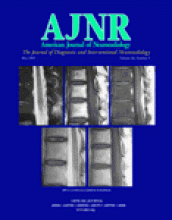Abstract
BACKGROUND AND PURPOSE: Monitoring of intraparenchymal brain tissue oxygen tension (PbrO2) is an emerging tool in neurocritical care. The purpose of this study was to determine if there is a relationship between CT perfusion (CTP) imaging parameters and PbrO2.
METHODS: Nineteen patients underwent continuous PbrO2 monitoring with probes placed to target white matter in the cerebral hemisphere. Twenty-two CTP studies were performed at the level of the oxygen electrode, as identified on concurrent nonenhanced CT. CTP analysis software was used to measure mean transit time (MTT) and cerebral blood volume (CBV) and to derive cerebral blood flow (CBF) for a region of interest (ROI) surrounding the oxygen probe. For correlation, PbrO2 levels and other physiologic parameters were recorded at the time of CTP.
RESULTS: PbrO2 values at the time of CTP were 2.7–54.4 mm Hg, MTT was 1.86–5.79 seconds, CBV was 1.18–8.76 mL/100 g, and CBF was 15.2–149.2 mL/100 g/min. MTT but not CBV or CBF was correlated with PbrO2 (r = −0.50, P = .017). MTT, CBV, or CBF were not correlated with other physiologic parameters, including mean arterial pressure, cerebral perfusion pressure, intracranial pressure, and fraction of inspired oxygen. On multivariable analysis, only PbrO2 was independently associated with MTT.
CONCLUSION: CTP assessment of ROI surrounding an oxygen probe in the intraparenchymal brain tissue is feasible and showed a significant correlation between PbrO2 and MTT. Further studies are warranted to determine the role of CTP in assessing acute brain injury and whether it can be used to prospectively identify brain regions at risk for tissue hypoxia that should be targeted for advanced neuromonitoring.
- Copyright © American Society of Neuroradiology












